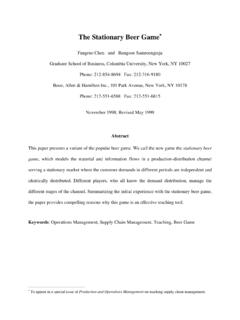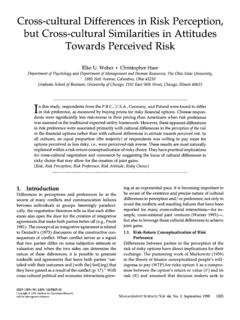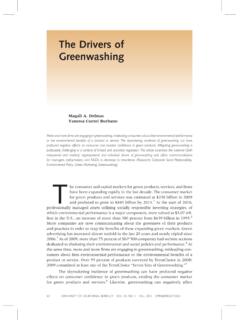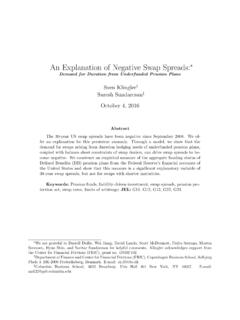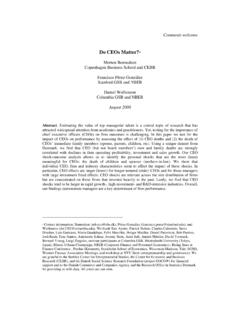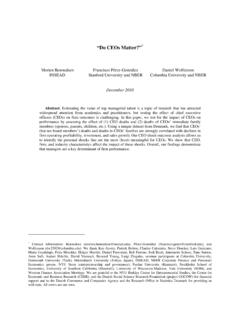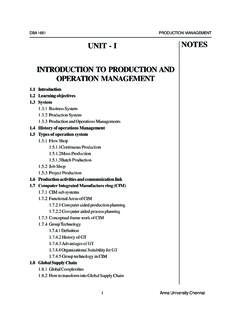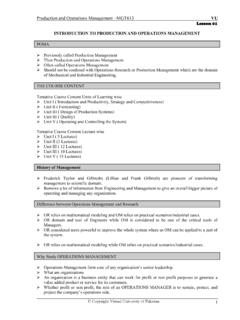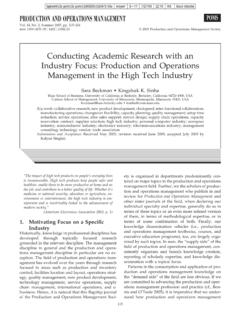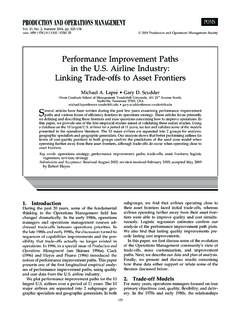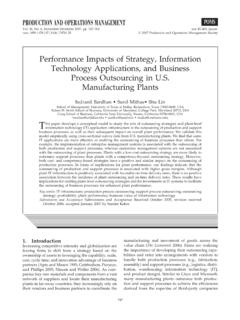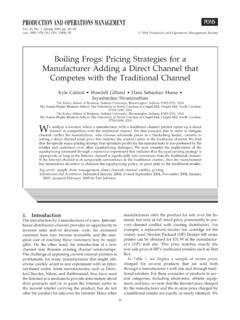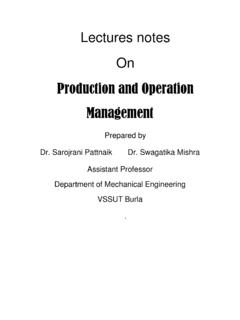Transcription of PRODUCTION AND OPERATIONS MANAGEMENT …
1 PRODUCTIONANDOPERATIONSMANAGEMENTVol. 17, No. 3, May June 2008, pp. 235 237issn1059-1478 eissn1937-5956 08 1703 2008 PRODUCTION and OPERATIONS MANAGEMENT SocietyOperations in the Service Industries:Introduction to the Special IssueUday ApteGraduate School of Business and Public Policy, Naval Postgraduate School, Monterey, California 93943, MaglarasGraduate School of Business, Columbia University, New York, New York 10027, PinedoStern School of Business, New York University, New York, New York 10012, special issue ofProductionandOperationsManagementoffer s a sample of ongoing research that focusescurrently on the services industries. The articles selected cover a spectrum of application areas as well : service industries; call centers; health care; financial services1. IntroductionThe service sector represents the largest and thefastest growing segment of the economies of theUnited States and othe rdeveloped count ries.
2 Fo rexample, in 2006, services accounted for roughly 83%of the total employment in the United States. Theshee rsize and continuing g rowth of the se rvice sec-to rand of se rvice occupations, the lack of significantproductivity improvement within services, and a latestart in the research on the operational issues of ser-vices make service OPERATIONS an important and fertilearea of research. Lately, there has been an increase inthe research on service OPERATIONS (Smith et al. 2007).In 2002, theCollegeofServiceOperations(CSO) waslaunched within the PRODUCTION and OPERATIONS Man-agement Society (POMS) to address this need forresearch in service OPERATIONS . The goals of CSO alsoinclude the development and nurturing of a commu-nity of scholars and practitioners who are interestedin the research and teaching of service operationsmanagement.
3 Activities of CSO that have been par-ticularly useful in promoting research in service oper-ations include organizing research conferences andguest editing special issues ofProductionandOpera-tionsManagementfocu sing on service special issue is a result of a conference thatthe POMS College of Service OPERATIONS held atColumbia University in December of 2004. The mainorganizer of the conference was Professor NelsonFraiman from Columbia University. The conferencewas sponsored, in addition to the CSO of POMS,by the Graduate School of Business at Columbia, theStern School of Business at NYU, the Wharton Schoolat the University of Pennsylvania, the School of Man-agement at Yale, and IBM. Over 50 papers were pre-sented covering all aspects of service OPERATIONS . Anumber of papers from this conference were subse-quently submitted to POMS fo rthis special issue,and eight of the papers submitted were selected ContentsResearch in service OPERATIONS can be classified ina variety of ways that either highlights its industryfocus, the key underlying questions, or the method-ological tools that are applied in each case.
4 The papersin this special issue represent the spectrum of theareas and research disciplines spanned by the grow-ing field of service OPERATIONS . They include method-ological papers as well as papers that are based onempirical research. (A significant amount of researchove rthe last decade has indeed been based on empi r-ical research; see Gupta et al. 2006.) The eight papersare grouped as first two papers in this issue focus on thebroader and more strategic issues in managing ser-vice ope rations. The pape rby Spoh re rand Maglioof IBM, entitled The Emergence of Service Science:Toward Systematic Service Innovations to AccelerateCo-Creation of Value, provides an industry perspec-tive on issues related to service innovation. In theirview, service innovations are going to play a criticalrole in fueling economic growth and raising the qual-ity and productivity level in services in the future.
5 Thispape ra rgues fo rthe eme rgence of a se rvice science a new interdisciplinary area of study to address thechallenges that underlie the services , Maglaras, and Pinedo:OperationsintheServiceIndustries2 36 PRODUCTION and OPERATIONS MANAGEMENT 17(3), pp. 235 237, 2008 PRODUCTION and OPERATIONS MANAGEMENT SocietyThe second paper, Experience, Service OperationsStrategy, and Services as Destinations: Foundationsand Exploratory Investigation, by Voss et al. uses amultiple-case study approach to introduce the notionof experience-centric services and examines its impli-cations on OPERATIONS strategy. The authors assert thatthe new role of OPERATIONS strategy is one of chore-ographing the service delivery system to create anddelive rtotal expe rience fo rthe custome r. The pape roffers a service OPERATIONS strategy framework thatcomprises four MANAGEMENT -controlled levers: stage-ware, orgware, linkware, and next two papers in this special issue focus onthe financial services industries.
6 The paper by Menorand Roth, New Service Development Competenceand Performance: An Empirical Investigation in RetailBanking, describes an empirical study on new ser-vice development (NSD) in retail banking. It finds thatNSD depends on four inter-related and complemen-tary factors, namely, (1) NSD strategy, (2) formalizedNSD processes, (3) market acuity, and (4) informationtechnology use and thei rpape rentitled A Specialized Invento ryProblem in Banks: Optimizing Retail Sweeps, Nairand Anderson study issues surrounding the manage-ment of retail deposit sweep programs in depositoryinstitutions. Deposits held at Federal Reserve banksrepresent an important component of the businessactivity of most depository institutions. Managingthese deposits, however, is a complex and challeng-ing issue, since the depository institution must fol-low statutory reserve requirements set by the FederalReserve Bank while receiving no interest on suchdeposits.
7 The pape ruses a stochastic dynamic p ro-gramming model to propose optimal policies for man-aging the sweep following two papers focus on call center oper-ations. Call centers are one of the most importantchannels through which firms interact with their cus-tomers, acting both as a service center and a pointof sales. In addition, modern call centers employ mil-lions of people worldwide, marking their socioeco-nomic role in today s and global economies. Thestudy of the economic and operational design andcontrol of call centers is central to the field of ser-vice OPERATIONS . A significant amount of research hasfocused in the past on call centers (see the excellentsurvey paper by Aksin et al. 2007). In this specialissue, two central problems within this research areaare being considered, namely, the effect of pooling inthe design of such systems and the routing controlproblem in call centers with multiple agent pools withdifferent skill should the service system use one cross-trained pool of agents as opposed to multiple, dedi-cated groups of agents to handle its call traffic?
8 VanDijk and van de rSluis ( To Pool o rNot to Pool in CallCenters ) study this question and identify conditionsin terms of the blend of demand rates and respectiveservice times for the various types of calls that favorthe use of cross-trained agents and a pooled rand Van den Sch rieck ( Optimizing theStaffing and Routing of Small-Size Hierarchical CallCenters ) study the staffing and routing control prob-lems in small-scale call centers that handle multipletypes of customers through many pools of agentswith different skill levels. They propose a compu-tational algorithm to find the optimal staffing androuting policy for small-scale call centers that opti-mizes the inherent trade-off between the gains result-ing from pooling effects due to the use of cross-trained agents with the increased staffing costs ofthese et al.
9 ( Assessing Markups, ServiceQuality, and Product Attributes in Music CDs Inter-net Retailing ) focus on the retail industry and, inparticular, consider the effects of service quality onInte rnet comme rce. Thei rpape rinvestigates empi ri-cally the trade-offs between premiums, service qual-ity, and product attributes in an Internet supply chainthat consists of three echelons, namely, a customer,a retailer, and a wholesaler. They conclude that highmargins are associated with superior performance byInternet retailers across several service quality dimen-sions; , there is a service premium effect. Thus,when consumers shop for homogeneous goods on theInternet, they face a trade-off between retail premi-ums and service last pape rconside rs the health ca re indus-try.
10 The health care sector is an important segmentof the services industry. It is perhaps a worldwidephenomenon that health care delivery systems oper-ate with constrained resources, often under inefficientprotocols. Irrespective of the quality of the servicesrendered, their delivery tends to be characterized bylong delays and poor patient experiences. Cayirli et al.( Assessment Of Patient Classification in Appoint-ment System Design ) study the topical problem ofpatient classification and its impact on appointmentsystem design. The typical performance measures ofsuch systems involve the doctor s idle time, the doc-tor s overtime, and the patients waiting times. Thework by Cayirli et al. shows that classifying patientsin terms of their anticipated needs and using thatinformation in sequencing patients and allocatingappointments intervals to them can have a dramaticeffect on all of the above service Future TrendsAlthough it is hard to offer a comprehensive reviewof the evolving field of service OPERATIONS within theApte, Maglaras, and Pinedo:OperationsintheServiceIndustriesP roduction and OPERATIONS MANAGEMENT 17(3), pp.
